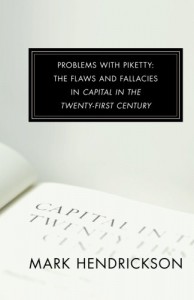French economist Thomas Piketty’s Capital in the Twenty-First Century was the most talked about treatise on political economy in 2014, if not the 21st century. To those of us who understand and respect the superior productivity and fairness of free markets, the errors throughout Piketty’s Capital were so numerous and obvious that the book was easy to dismiss as warmed-over leftism, hardly worthy of being addressed and refuted. The history of economics teaches us, however, that it can be a costly mistake to ignore a popular book however flawed and wrong-headed [2].
When John Maynard Keynes published The General Theory of Employment, Interest and Money in the winter of 1935-36, its fundamental errors were so glaring to the Austrian economist Friedrich Hayek that Hayek figured the book would quickly slip into oblivion. Wrong! By the time Henry Hazlitt wrote the first systematic dissection and demolition of The General Theory in 1959 (The Failure of “the New Economics”) Keynes’ macroeconomic errors had become the orthodoxy.
With the Keynes/Hazlitt precedent in mind, I decided to give Piketty’s book a thorough going over. The result, published in November by the Center for Vision and Values at Grove City College [3], is a concise book (slightly under 100 pages) entitled, Problems with Piketty: The Flaws and Fallacies in “Capital in the Twenty-First Century.” [2]
Here are some of the main points:
- Piketty shows a startling ignorance of what capitalism is. Ignoring the essence of capitalism—private property, voluntary exchange, and open, competitive markets—he attempts to redefine it in terms of a simple accounting formula involving capital’s share of national income.
- In one of several sweeping unfounded assertions, Piketty claims that there is an “unsustainable” gap between the rich and the non-rich, and that if government doesn’t aggressively shrink this gap, a dire but unspecified societal calamity will ensue. Piketty never explains the “what,” “how,” and “why” of such a calamity, but simply asserts that this vague, mystical bogeyman lurks nearby.
- Piketty published copious data allegedly proving that wealth is becoming more unequally distributed. Although numerous competent economists have demolished his data, Piketty nevertheless scored a victory. He moved the focus of attention to statistical measures of the distribution of wealth, when instead the crucial question for the economic wellbeing of society is: How are fortunes being earned? Are they being earned fairly and beneficially by providing valuable goods and services to others in a free, competitive marketplace—or unfairly—that is, through the age-old corrupt process of those with political power rigging the system and picking economic winners and losers (e.g., feudalism, mercantilism, socialism, cronyism)? When freed from political control, capital—the key ingredient of wealth creation—is not the social scourge conjured up by Piketty, but a great social benefactor.
- His blind spots are equally glaring: He gives short shrift to pro-growth policies; he doesn’t draw the obvious connection between high government spending and high public debts; and for a book ostensibly about “capital,” the author says virtually nothing about the economic function of capital or how capital increases.
- His pro-government bias is glaring. He ignores government cronyism but blames free markets for various economic disruptions caused when governments restrict, subvert, and suppress free markets. Indeed, his default proposal is always for more government control—higher taxes, more government economic planning, and greater collaboration between the governments of the world against wealthy private interests.
- Piketty’s book is riddled with flawed modes of economic analysis [2]. Here is a partial list: He disregards incentives; clings to vestiges of the long-defunct labor theory of value; applies static analyses to a dynamic world; attributes no blame to government policy mistakes for the financial crisis of 2008-9; credits both taxes and inflation with nonexistent benefits; and mangles the history of America’s Great Depression, our graduated income tax, and federal minimum wage laws.
The list above is not exhaustive, but hopefully shows that Piketty’s mistakes are not trivial, but fundamental and not rare, but pervasive.
If you know of a college student or adult with an inquiring mind who wants to understand what divides free-market economists from the progressive political agenda, Problems with Piketty [2] is a helpful place to start.
